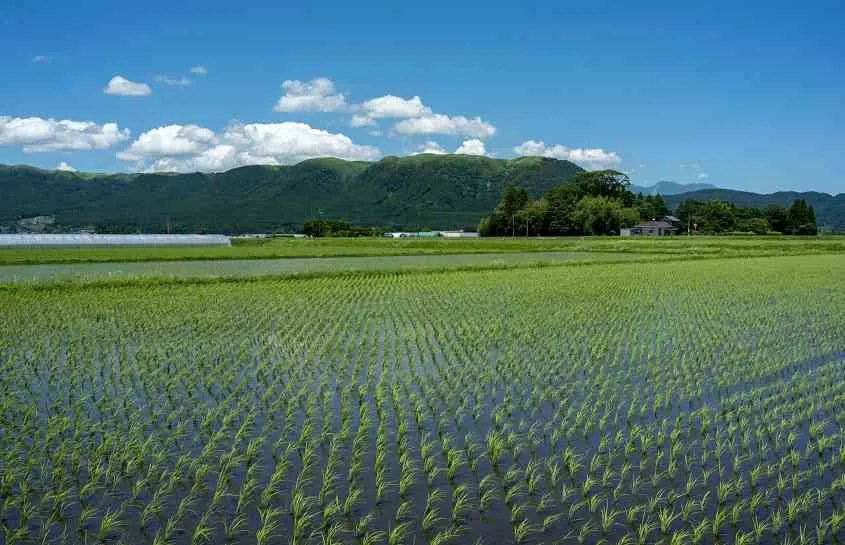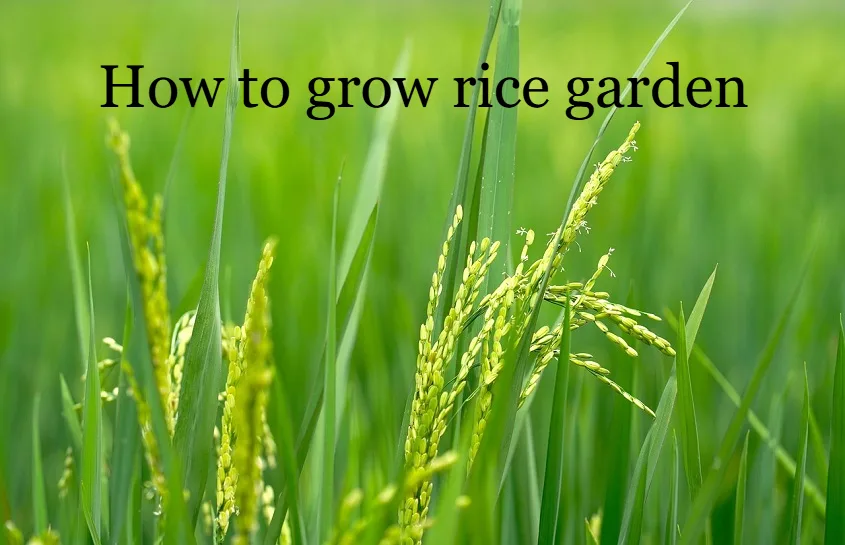You don’t need acres of land or tropical weather to grow your own rice. In fact, with the right knowledge and a few smart tweaks, it’s possible to figure out how to grow rice garden in almost any climate, no matter where you live.
The idea may sound strange at first. After all, rice is usually associated with wet rice in places like Southeast Asia or Central America. But here’s the thing: People are growing rice in raised beds, buckets, and even rooftop containers. And it works.
Growing rice at home may seem unconventional, but it’s gaining popularity among sustainable gardeners.
In this guide, we’ll explore how to grow rice garden in different climates—no matter where you live.
Why People Are Starting to Grow Rice at Home
There’s something deeply satisfying about growing your own food. Rice, being a staple for billions of people, is often overlooked by home gardeners. Most assume it’s too complicated or only possible in hot, wet places.
But the trend is changing. Companies like Rice Garden Inc have been promoting sustainable rice farming methods for small-scale growers. And with a few tricks, growing rice becomes a doable (and fun) home project.
Whether you live in the hills of Oregon, the suburbs of New Jersey, or even somewhere tropical like near the Hilton Garden Inn San Jose Costa Rica, you can tailor the method to your location.
Know Your Rice: Choosing the Right Variety
Before planting anything, it’s important to select a rice type that suits your environment. This is the key to learning how to grow rice garden in any condition.
Types of Rice:
- Lowland (paddy) rice: Needs lots of water and typically grown in flooded fields.
- Upland rice: Grows like a regular grain, without the need for flooding.
- Short-season rice: Perfect for colder regions with shorter summers.
If you live in a dry area, go for upland rice. If you have access to water and warm temps, paddy rice is an option.
Materials You’ll Need
Setting up your rice garden isn’t expensive. Most items can be found at local hardware or gardening stores.
- Rice seeds (upland or paddy)
- Rich soil (loamy or clay works well)
- Compost or organic fertilizer
- Watering system or buckets
- Large containers or small garden bed
One creative gardener we spoke to even used garden tomato and basil rice cakes wrappers as mulch in her rice bed—talk about recycling with flavor!
Step-by-Step Rice Planting Instructions

Step 1 – Soaking Seeds
Grab a handful of rice seeds. Doesn’t matter if they’re store-bought or saved from a past harvest. Toss ’em into a bowl. Add enough water to cover. Leave it. Go do something else for the day. 24 hours, maybe a bit more if you forget. No big deal. You’ll see them swell up a little. That’s all you need.
Step 2 – Get the Soil Ready
Now for the dirt. You want it moist. Not soggy. Not dry. Just… nice and damp. If it’s crumbly, add compost. I usually mix in whatever I have—banana peels, crushed leaves, that kind of thing. Use a bucket, planter, or a patch in the yard. Deep enough, maybe a foot. More is fine. Rice roots dig in deep.
Step 3 – Put the Seeds In
Once they’re soaked, go ahead and plant. Don’t overthink it. Poke a little hole—half an inch maybe—and drop the seed in. Cover lightly. That’s it. Do a few in a row. Or scatter some if you’re short on space. Just don’t cram them too tight. Give ’em breathing room.
Step 4 – Watch the Weather
Cold out? Don’t risk it. Keep the pot inside near a sunny window. Warm and cozy. Once it feels like spring, move them out. If you live somewhere hot, you’re already good to go. Just leave the plants where the sun hits most.
Watering Techniques for Different Climates
Water is critical, but too much or too little can cause problems. The trick to how to grow rice garden is mastering the watering game.
Wet Climates (e.g., Costa Rica)
Use controlled flooding for paddy rice. You can build mini-dikes around your garden bed. This method mimics traditional rice farming.
Dry Climates
Stick with upland rice. Drip irrigation works well here. Cover the soil with mulch (you could even crumble leftover garden tomato basil rice cakes as compost if you’re into zero waste gardening).
Temperate Zones
Keep soil moist using hand watering or a sprinkler on a timer. Growing in containers helps regulate water better during variable seasons.
Container Rice Gardening: A Space-Saver’s Delight
No yard? No problem. You can grow rice in containers with just a bit of care.
Use wide, deep tubs or barrels. Fill them with loamy soil, plant the seeds, and keep them near a sunny spot. Add water as needed. This method is ideal for balconies, rooftops, and patios.
Bonus tip: If you’re traveling to the tropics and staying somewhere like Hilton Garden Inn San Jose Costa Rica, take note of how local farmers use container methods in tight urban spaces—it’s amazing what they can do with a few buckets and some sunlight.
Rice Growth Timeline: What to Expect
Here’s a rough schedule of how your rice plants will develop:
| Stage | Timeframe |
| Germination | 5–10 days |
| Seedling stage | 2–3 weeks |
| Tillering (leaf production) | 3–5 weeks |
| Flowering | 2–3 weeks |
| Maturity | 3–4 weeks |
Altogether, expect about 90 to 120 days from planting to harvest.
Harvesting Your Rice

When the grains start turning golden and the stalks begin to droop, your rice is ready.
- Cut the stalks and bundle them together.
- Hang them upside down in a dry, shaded spot for a few days.
- Once dry, rub the grains off by hand or using a mesh screen.
You’ve done it. You’ve learned how to grow rice garden, and now you’re ready to enjoy your home-grown grains.
Common Problems and How to Solve Them
Even the best gardeners run into problems. Here are a few you might face:
1. Leaves turning yellow
Cause: Nutrient deficiency
Fix: Add compost or natural fertilizer like fish emulsion.
2. Stunted growth
Cause: Poor soil or cold temperatures
Fix: Try planting in containers and move to sunnier, warmer spots.
3. Pests
Aphids and rice borers can be a problem. Neem oil spray or garlic water can help.
If you’re already into healthy snacks like garden tomato and basil rice cakes, save those empty wrappers and see if you can repurpose them into plant markers or mulch layers—seriously, gardeners are getting creative!
Sustainability and Community Growing
A big part of learning how to grow rice garden successfully is understanding its impact. Growing your own food reduces your carbon footprint and connects you to the food you eat.
Organizations like Rice Garden Inc promote educational workshops and small-scale farming projects for families and schools. You don’t have to be a farmer to make a difference.
Rice Garden Inspiration from Around the World
From the terraced fields of Asia to community gardens in Los Angeles, rice is making a comeback in home gardening.
People in apartments are using hydroponics. Suburban families are converting front yards into edible landscapes. Even travellers staying at eco-conscious hotels like Hilton Garden Inn San Jose Costa Rica are getting inspired to try small-scale rice plots when they return home.
Final Thoughts – Honestly, Growing Rice Isn’t That Hard
You know, when you first think about growing rice, it can seem a bit much. I mean, flooded fields and all that, right? But once you try it, it’s not that complicated. It’s kind of like planting other stuff—just takes some patience and care.
By now, you’ve got a pretty good idea of what to do. Maybe it’s a few pots on your balcony, a corner of your backyard, or even a school project with the kids. Doesn’t matter where you start.
FAQ: How to Grow Rice Garden
Q: Can rice grow in cold climates?
A: Yes, but use short-season or upland varieties. Start indoors if needed.
Q: Do I need a flooded field to grow rice?
A: No. Upland rice varieties grow well in moist soil without flooding.
Q: How long does rice take to grow?
A: Usually between 90 to 120 days, depending on the type and climate.
Q: Can I grow rice in pots?
A: Absolutely. Just make sure they’re deep enough and placed in full sun.
Q: What can I do with leftover garden tomato basil rice cakes?
A: Compost them or use them as mulch. They’re full of organic matter and break down well.

